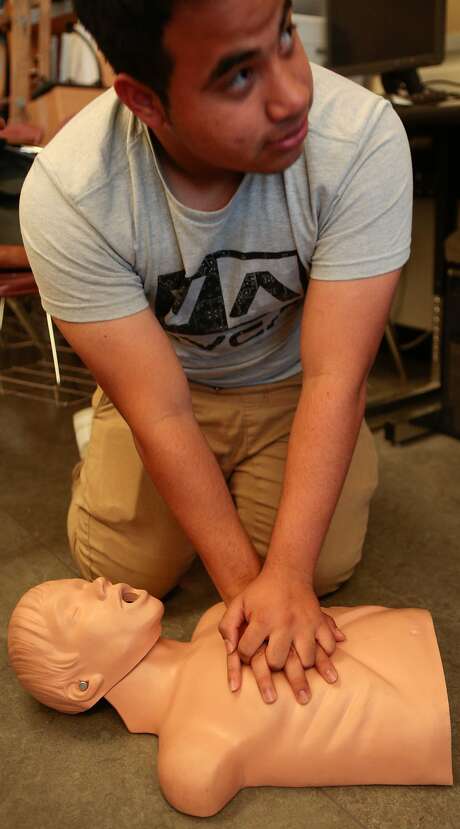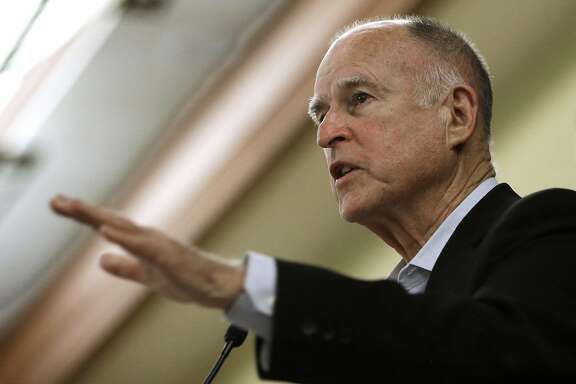By Jill Tucker, San Francisco Chronicle | http://bit.ly/1OmRAxA

Photo: Nathaniel Y. Downes, The Chronicle From left, Alejandro Atilano Cornejo, Chris Saniere and Austin Wong from Ali Mayer's 9-12 grade Health Education class at Abraham Lincoln High School watch a video about Hands Only CPR on Monday, Oct. 5, 2015 in San Francisco, Calif.
October 6, 2015 Updated: October 6, 2015 4:15pm :: California kids will get one of the most rounded educations on sex and sexuality in the country under new legislation that advocates called a victory in providing information that could prevent disease and teen pregnancy as well as sex-based violence and prejudice.
The new mandate ensures that public school students get a comprehensive sex education, offered at least once in middle school and once again in high school. That means teaching about condoms and emergency contraception, abstinence and abortion, sexual consent, gender identity and sexual orientation.
More on Sex Ed
-
Governor signs bill mandating sex ed in schools across California
- Opinion: Why the feds should butt out of sex education
-
Abstinence-only curriculum is not sex education, judge rules
Under the measure signed by Gov. Jerry Brown last week, individual parents can opt out, but schools cannot.
“I think this new law really vaults California into a leadership role nationally on this issue, particularly in terms of the content related to LGBTQ youth and needing to affirmatively address gender identity and sexual orientation,” said Phyllida Burlingame, reproductive justice policy director at the American Civil Liberties Union of California, which co-sponsored the legislation.
California school districts have been required to offer curriculum on HIV/AIDS prevention, but sex education was optional. While most districts chose to offer it, the content and the topics covered varied widely, with some avoiding contraceptives in favor of abstinence or avoiding sexual orientation or gender identity entirely.
The new law was backed by a list of education leaders and community groups as well as the state PTA, Burlingame said. “This is something that educators in California really felt they needed,” she said. “It’s in the interest of local education agencies to have a clearer, stronger law at the state level.”

Photo: Nathaniel Y. Downes, The Chronicle | Jonathan Cerrato Cruz from Ali Mayer's 9-12 grade Health Education class at Abraham Lincoln High School practices Hands Only CPR on Monday, Oct. 5, 2015 in San Francisco, Calif.
Some districts ahead
The law kicks in Jan. 1, and while some districts will have to create sex education and HIV/AIDS prevention courses — or revamp the ones they have now — officials in San Francisco and Oakland said they’re already in compliance.
Oakland, for example, offers a weeklong sex education course in ninth-grade English and science classes in the spring. The classes include physiological and anatomical information as well as practical knowledge like condom demonstrations, in addition to conversations about sexual consent, values and norms and healthy relationships, said Ilsa Bertolini, program manager for the district’s HIV/STD prevention program.
“We’re teaching all of our students to communicate all of their needs effectively to become consenting, healthy adults,” she said. “I think it gives the students a chance to talk about what they read and hear and see.”
Parent Miranda Martin has a fifth-grader in San Francisco schools and believes her daughter should get not only the ABCs in schools, but information on sex and sexual health as well.
“I kind of think the more the better, as long as it’s in the right environment,” she said, adding that she believes schools are a safe and supportive place for those conversations. “You have no idea what they’re being exposed to out of school.”
California sees 5,000 new HIV infections each year, a statistic linked to high rates of sexually transmitted diseases. The gonorrhea rate for teenagers 15 to 19 is 185.2 per 100,000 in the state, but is much higher for African Americans — and black females in particular, who have a rate of 1,397.5 per 100,000.

Photo: Nathaniel Y. Downes, The Chronicle Yumei Zhao from Ali Mayer's 9-12 grade Health Education class at Abraham Lincoln High School listen to a lecture about Hands Only CPR on Monday, Oct. 5, 2015 in San Francisco, Calif.
“Our schools are a critical environment for providing young people with the knowledge and skills that they will need to protect their sexual health,” said the bill’s author, Assemblywoman Shirley Weber, D-San Diego. “This is about empowering all young men and women — whatever their orientation or gender — to make the healthiest decisions possible.”
Still, sex education is always a touchy topic, and the Bay Area has seen its share of controversy. In Fremont last year, parents protested when the district adopted a health textbook that they considered too sexually explicit, with its diagrams of male and female sexual organs in various stages of arousal. The school board backed off the book.
Alameda protest

Photo: Nathaniel Y. Downes, The Chronicle Captain Zack TIbbets fields questions from students in Ali Mayer's 9-12 grade Health Education class at Abraham Lincoln High School on Monday, Oct. 5, 2015 in San Francisco, Calif.
In 2009, many parents in Alameda were outraged — and some sued — after the district sought to reduce bullying with 45 minutes of yearly instruction on differences in families and other topics related to sexual orientation. The second-grade lesson included a story about two male penguins adopting an egg and raising the chick. The district eventually broadened the curriculum to include gender, religion, race and other issues that may be associated with bullying.
The law signed by the governor Thursday emphasizes that schools must “affirmatively recognize that people have different sexual orientations and, when discussing or providing examples of relationships and couples, shall be inclusive of same-sex relationships.”
“This legislation ensures that all students have access to medically accurate and unbiased sexual health education,” said state Superintendent of Public Instruction Tom Torlakson. “By affirmatively recognizing that people have different sexual orientations and teaching pupils about gender identity, LGBTQ youth will be safer in school.”
New law’s critics
The Legislature passed the measure in late September, largely along party lines, and the governor signed it with little fanfare. But some critics saw politics infringing on education.
“School districts now have no choice based on their own community attitudes whether sex education is appropriate and the degree of sex ed is appropriate,” said Brad Dacus, an attorney and president with the Pacific Justice Institute, which focuses on cases related to religious freedom and parental rights.
The law requires districts to communicate how successfully treated HIV-positive people can have a normal life expectancy, which offers a “positive spin” on AIDS, Dacus said.
“At no time should political agendas shortchange a straightforward and truthful education,” he said. “The controversial provisions, without question, make this legislation a huge mistake for the health and safety and balanced truth that is needed for students in our public schools.”
Jill Tucker is a San Francisco Chronicle staff writer.




No comments:
Post a Comment